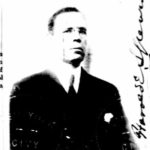I love old pioneer homes, especially those with Victorian elements. West Palm Beach was once the “Cottage City,” and filled with these lovely homes with their towers, gingerbread, and shingle features. Very few of these homes have stood the forces of nature – whether it be hurricanes, termites, or worst of all, the bulldozer; their numbers ever dwindle. I posted a picture of the Leamington, a small boarding house that stood near where the Meyer Amphitheatre is today. A friend, Jeannie Hoban, commented that it looked very much like a house she once owned at 201 Monceaux Road in West Palm Beach.
Intrigued, I looked up the house on Google Maps, then did the usual research – looked up the property on the tax assessor site, looked at the build date, and located the plat. I also looked for references to 201 Monceaux Road in the Palm Beach Post archive. The tax assessor site had the build date as 1925, which didn’t make sense to me for that style of house. The state survey said the house was built in 1927, and the Historic Preservation plaque on the house has the date as 1908. In the 1930s papers, I found that a Harold E. Spencer was living in the house at 201 Monceaux. The plat revealed that Spencer had platted the land in 1926 as Monceaux, a lovely French name in a sea of Spanish-sounding names such as El Cid. I wondered why Spencer would have chosen lot 6 for the house, away from the waterfront along Lake Worth, to place his house.
I searched in the Palm Beach Post archive and found a 1920 reference to a 1903 fire. 1903 had been a bad year for fires in the area, with the original Breakers Hotel, Eugene Dimick’s house in Palm Beach, and a mention that Spencer’s house all had gone up in flames. So I searched for that event, and a tragic one it was. In August 1902, Spencer had come to West Palm Beach looking for land. He bought acreage in the farming area that was once along the waters of Lake Worth, between West Palm Beach and what would become the town of Lake Worth. He built a two-story house overlooking the lake. Spencer’s brother Earnest, along with caretaker Herbert Zentis, were working on the house, readying it for his brother and their elderly parents imminent arrival. Several train cars of furniture were in the house, and the grounds had been planted with pineapples and orange trees.
The October 17, 1903 Tropical Sun reported that Earnest Spencer awoke to find his upstairs bedroom filled with smoke. He opened the door and was hit with flames, burning his hands and arms. He shut the door and crawled out a window onto the veranda roof, and jumped down. He heard Zentis scream, and tried to rescue him with a ladder, but the flames were too much. Clad only in his nightshirt and badly burned, he bicycled to the nearest neighbor, George C. Matthams, a prominent pineapple grower. Dr. Richard Potter was summoned to care for Earnest. A rescue party went to Spencer’s property, and found only a smoldering ruin – of poor Zentis, only some bones remained from the inferno. His remains were buried in Lakeside Cemetery, in a child’s casket.
Harold Spencer arrived in West Palm Beach in November, 1903. According to the November 4, 1903 Tropical Sun, Spencer planned to start rebuilding as soon as possible. And it was from that article that the true date of the Spencer house can be reasonably deduced – 1904. That makes it one of West Palm Beach’s oldest surviving cottages. When the land was platted in 1926, the house was moved from its original site to lot 6. According to Lewis Sorrell, who grew up in the neighborhood, the house stood in the middle of what would become Monceaux Road. Spencer moved the house north and turned it so the front door faces the east.
I became more intrigued about Spencer – who was he? Research through Ancestry.com and Newspapers.com revealed him to come from a blue-blood family of Tarrytown, New York.
His father, James S. Spencer, was a rector in the Christ Church parish for 61 years. Harold Eldredge Spencer was born in 1871, and graduated from Columbia Law School and also attended Oxford University. He practiced law in New York. During World War I, he volunteered as an ambulance driver in France. His parents and brother lived with him in the house in what would become the south section of West Palm Beach. He sold the house in the 1940s to a widow, Mrs. G. Ray Sparks, whose son would become a West Palm Beach mayor. Harold Spencer passed away in 1955 at the age of 84. Jeanne and George Hoban bought the house from the Sparks family and lived there for many years. Jeanne’s instincts told her that the house was older than most thought, and she was right. She provided to me a floor plan of the house. Its layout, with bedrooms at each corner of the second floor, perfectly matches the description of the terrible fire.
And finally, the name Monceaux – what was its origin? Newspaper accounts had said it was named for Monceaux, France where Spencer’s mother had been born. But that proved not to be the case. In fact, his mother’s maiden name was Mary Francis Mounsey, and she was born in New York. Phonetically, Mounsey and Monceaux do sound much the same. Mounsey could be mistaken for “Mousy,” a rather unromantic name for a subdivision. Monceaux had a much better sound.
Now, the history of the cottage is complete. We can safely wish the house a happy 115th birthday.










Hi Ginger Its Russell Gulick. I haven’t heard from you in a while. Hope all is well. Keep in touch.